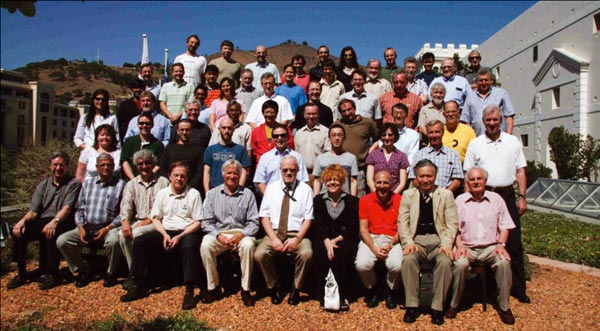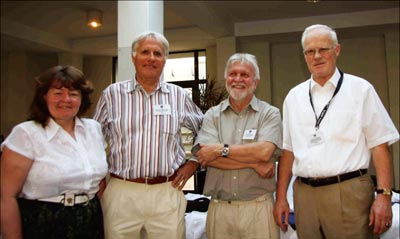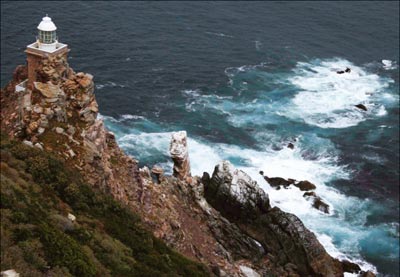A report from the latest conference in the BEYOND series.

Image credit: H V Klapdor-Kleingrothaus.
The Fifth International Conference on Beyond the Standard Models of Particle Physics, Cosmology and Astrophysics (BEYOND 2010) took place earlier this year in Cape Town. With 87 participants from all over the world and 73 presentations, it gave a broad view of the status and future of particle physics beyond the Standard Model. Although the meeting took place just before the LHC entered a new energy region at 7 TeV in the centre of mass, it allowed the presentation of some first results from 2009 and a look at what lies in store. Other highlights centred on areas beyond the Standard Model that are already under investigation, either theoretically or experimentally. This report, however, can mention only part of the broad range of topics and a few of the excellent speakers.
With the prospect of a few 100 pb–1 integrated luminosity to be delivered by the LHC during 2010, Claude Guyot of Saclay discussed the discovery potential of the ATLAS experiment. Silvia Costantini of CERN and the CMS experiment pointed out the challenges of the search for a fourth generation of quarks and for exotic partners of the top quark. An additional quark generation could account for the asymmetry between matter and antimatter; and natural, nonsupersymmetric solutions of the hierarchy problem generally require fermionic partners of the top quark with masses that are not much heavier than about 500 GeV. The LHC also has exciting potential in the areas of B physics and CP violation, particularly with the LHCb detector, as Jacopo Nardulli of the Rutherford Appleton Laboratory outlined. On the theoretical side, Thomas Appelquist of Yale reviewed recent work on the role of approximate conformal symmetry in strongly coupled theories, on which the LHC will begin to shed light. Flavour physics in warped extra dimensions is another topic on this level, with hidden sectors and hidden extra dimensions discussed by CERN’s Ignatios Antoniadis. More down to Earth, the Minimal Supersymmetric Standard Model allows estimates of the possible production rates at the LHC of long-lived superparticles.
From neutrinos to Q balls
Neutrinos have already provided the first hints of new physics through their non-zero mass, which leads to neutrino oscillations. The study of their elusive properties continues in experiments on double-beta-decay, tritium-decay and reactor neutrinos, as well at accelerators. Present and near future double-beta-decay experiments, including a variant of the Cryogenic Underground Observatory for Rare Events (CUORE) called LUCIFER, are still far from being able to test the 6.4 σ evidence for neutrinoless double-beta decay observed in the Heidelberg-Moscow experiment, which took data in the Gran Sasso National Laboratory for 13 years. Even the huge KATRIN tritium-decay experiment at Karlsruhe can check for a neutrino mass of 0.2 eV – the lower limit for the electron-neutrino mass from the Heidelberg-Moscow experiment – only at the 1 σ level. The fastest independent measurement of the neutrino mass (and independent confirmation of the Heidelberg-Moscow result) might come from the PLANCK mission and – eventually – the Experimental Probe of Inflationary Cosmology (EPIC), NASA’s post-PLANCK mission. EPIC should have a neutrino-mass sensitivity of Σmν <0.05 eV and should test Super-Kamiokande’s result of Δm2 = 2 × 10–3 eV2, from atmospheric-neutrino oscillations.

Image credit: H V Klapdor-Kleingrothaus.
Reactor-neutrino experiments aim to determine the mixing angle Θ13 in the Maki-Nakagawa-Maskawa matrix. The Double Chooz experiment is expected to improve the current limit of sin22Θ13 <0.15 down to 0.03, and similar limits of 0.02 and 0.01 are expected from the Reactor Experiment for Neutrino Oscillation (RENO) at Younggwang and the Daya Bay experiment, respectively. This would allow, in three years or so from now, a check of the first hints for a non-vanishing Θ13, which were obtained in 2008 in a global fit of all neutrino-oscillation data to a three-flavour scenario. At accelerators, the long-baseline experiments OPERA and MINOS have not yet yielded results. The T2K experiment, using an intense muon-neutrino beam generated by the new J-PARC facility at Tokai, with the detector 295 km away at Kamioka, aims at measuring Θ13 down to sin22Θ13 <0.008. This ambitious experiment started operation in March. In the more distant future, neutrino factories (producing neutrinos by muon decay) will be important for determining Θ13 if the sensitivity of T2K proves to be insufficient, as Osama Yasuda of Tokyo Metropolitan University discussed. Neutrino factories will also tackle topics such as violation of unitarity arising from heavy particles, or schemes with light and sterile neutrinos.
Leptogenesis can provide a solution to the baryon asymmetry of the universe and here, as Marta Losada of Bogota outlined, the focus has moved from understanding the qualitative features to detailed quantitative analysis. Neutrino masses and mixings consistent with recent neutrino data can lead to the correct baryon/photon ratio of 10–10. The special case of electromagnetic leptogenesis considers the electromagnetic dipole-moment coupling between the light and heavy neutrinos, instead of the minimal Yukawa interactions, and again there is a strong connection between light-neutrino parameters and leptogenesis, as Sandy Law of Chung-Yuan University explained.
The decay μ→eγ, which is under study by the MEG experiment at PSI, is radiatively induced by neutrino mass and mixings, and extensions of the Standard Model enhance the rate through mixing in the high-energy sector of the theory. The result of the 2008 run, presented at the conference, gives the branching ratio for the decay as 3 × 10–11, with a limit of 5 × 10–12 expected for this year’s data. A positive result would yield evidence for physics beyond the Standard Model.
The search for exotic particles continues at accelerators and in cosmic rays. The best limit for penetrating grand-unified theory monopoles in cosmic radiation is still provided by the MACRO detector at Gran Sasso, and is close to the extended Parker bound, except at very high energies, where the best limits come from the AMANDA experiment at the South Pole and the Lake Baikal experiment. At the LHC, the MoEDAL detector – housed in the cavern of the LHCb detector – will search for magnetic monopoles. In the case of nuclearites, MACRO and the SLIM experiment (at a height of 5230 m at Chacaltaya, Bolivia) give the best limits, as Laura Patrizii of INFN Bologna outlined. The best limits for strangelets also come from the SLIM detector, with improvements expected from the Alpha Magnetic Spectrometer (AMS-02) mission, to be launched in February 2011. For charged Q balls, the best limits are from AMS-01, SLIM and MACRO.
Cosmological connections

Image credit: H V Klapdor-Kleingrothaus.
Dark matter provided a vibrant topic for discussion. Rita Bernabei of Rome presented data taken over 13 years by the DAMA/LIBRA (Large sodium Iodide Bulk for Rare processes) experiment, which show behaviour consistent with an annual modulation signature from dark matter in the galactic halo at a confidence level of 8.8 σ. The Cryogenic Dark Matter Search (CDMS) II ended operations in March 2009. This experiment looked for elastic scatters of weakly interacting massive particles (WIMPs) from germanium nuclei in a detector array of a few kilograms. From the start it was somehow the object of debate for its selection of data. After 612 kg days searching for WIMPs between July 2007 and September 2008 (compared with 317 697 kg days, or 0.87 tonne years collected by DAMA/LIBRA), the final result shows no significant signal for dark matter.
Imaging atmospheric Cherenkov telescopes (IACTs) can search for annihilations of WIMPs that could occur in high-density regions of our galaxy, such as the galactic centre. They look for high-energy gamma rays produced by effects of constraints on subhalo formation scenarios, such as spikes of dark matter around black holes of intermediate mass. Other theoretical candidates for dark matter, beyond the neutralinos that are a natural explanation in supersymmetry, include Kaluza-Klein particles, which arise in models with extra dimensions. Annihilation of such particles, gravitationally bound to the Sun, would produce neutrinos that could then give rise to muons and antimuons in Earth’s matter. The ICECUBE detector, at the South Pole, can put constraints on the parameter space for models with only one of two types of the lightest Kaluza-Klein particles.

Image credit: H V Klapdor-Kleingrothaus.
Dark energy was another hot topic. QCD provides an exciting approach that avoids the long-known discrepancy of the order of 10120 between the usual quantum vacuum-energy predictions of particle theory and the observed cosmological constant. QCD contains a massless dipole (the Veneziano “ghost”) that contributes to the vacuum energy and could make it numerically close to what is observed, as Federico Urban of British Columbia described. Lattice tests could confirm the existence of a Casimir QCD energy. A next step would be to gain a better theoretical understanding of the dynamics of the “ghost” in the expanding universe and to work out the consequences of its magnetic field in more detail. Another approach, presented by Gerard Stephenson of the Los Alamos theory group, investigates a connection between interacting Majorana fermions and cosmic acceleration. A system of fermions interacting through scalar exchange exhibits negative pressure when perturbed to densities less than the equilibrium density. On the basis of an adiabatic approximation, there are parameter ranges compatible with cosmic acceleration; the lightest supersymmetric particle could be a viable candidate fermion. A Majorana neutrino of mass around 0.26 eV would also be a candidate, which may be exciting in view of the neutrinoless double-beta-decay result from the Heidelberg–Moscow experiment.
An interesting, nonmainstream view of understanding dark energy was presented by Chris Clarkson of Cape Town. He argues that the huge Hubble-scale inhomogeneity has not been investigated in detail and could conceivably be the cause of apparent acceleration. If this is indeed the case, then we exist in a highly exceptional corner of the universe. The void models offer the possibility of describing dark energy as a radical inhomogeneity in a dynamically predictable model, rather than as an unknown dynamical degree of freedom in a postulated homogeneous model.
Astroparticle physics
A highlight of the conference was the presentation by NASA’s Malcolm Niedner of the potential of the rejuvenated Hubble Space Telescope and some early results. The Hubble Ultra Deep Field Infrared Survey is entering new territory in the redshift region z = 8–10. Within just a few weeks of operation, the new Cosmic Origin Spectrograph will probe more of the cosmic web than all previous Hubble spectrographs combined.
Back on Earth, at the South Pole the ICECUBE detector will start operation in 2011, following on from AMANDA, which was decommissioned in 2009, to study high-energy neutrino astronomy, atmospheric neutrinos and nonstandard oscillations. The ANTARES experiment, running in the Mediterranean Sea since 2006, has similar goals, focusing on high-energy cosmic neutrinos, the production mechanism of high-energy cosmic rays, high-energy processes in gamma-ray bursts and the study of binary systems and micro-quasars. ANTARES and ICECUBE cover complementary regions of the sky.
At lower energies, the BOREXINO experiment at Gran Sasso has new results on solar neutrinos. With the first real-time and simultaneous measurement of solar neutrinos from the vacuum-dominated region (7Be-neutrinos) and from the matter-enhanced oscillation regions (8B-neutrinos), the experiment claims to confirm the Mikheyev-Smirnov-Wolfenstein large mixing-angle solution of solar-neutrino oscillations at a 4 σ level. It has also improved the best limit on the neutrino magnetic moment. Future plans include a check of the 7% seasonal variation of the neutrino flux so as to confirm its solar origin.
The direct detection of gravitational waves would test general relativity in the strong-field regime and provide essential new information on objects such as neutron stars, black holes and the Big Bang.
Understanding the origin and composition of ultrahigh-energy cosmic rays (UHECRs) may shed light not only on astrophysical acceleration processes but also on fundamental particle interactions – hence the excitement surrounding the Pierre Auger Observatory in South America. However, the latest results on the energy spectrum of UHECRs beyond the Greisen-Zatsepin-Kuzmin (GZK) cut-off show that there is still no hint of physics beyond the Standard Model. The strategy for the future lies in Auger North, an array that is seven times larger, which is hoped will be sufficient for discovering new physics.
Very high-energy, gamma-ray observation of supernova remnants interacting with molecular clouds seems to be a new way to reveal cosmic-ray accelerators. Thanks to a high sensitivity and good angular resolution, the HESS IACT array in Namibia produces detailed images of galactic sources in the tera-electron-volt energy range. Several supernova remnants show a similar pattern, where an excess of very high-energy photons coincides with a maser (or possibly laser) signal, typical of a shocked molecular cloud, situated on the rim of the supernova remnant.
In the search for gravitational waves the first generation of interferometers is now operating at the design sensitivity. The direct detection of gravitational waves would test general relativity in the strong-field regime and provide essential new information on objects such as neutron stars, black holes and the Big Bang. As Peter Aufmuth of the Max Planck Institute for Gravitational Physics in Hannover explained, while no signal has yet been seen, the detectors should be close to making observations. As for the future, an advanced LIGO/Virgo detector is scheduled for 2014, to be followed in 2025 by the Einstein Gravitational Wave Telescope, with 10 times higher sensitivity, as well as NASA’s Laser Interferometer Space Antenna in 2022. All models for the unification of general relativity with quantum-field theory lead to (small) deviations from general relativity, which are least constrained experimentally at small and large scales. The CAsimir FORce and Gravitation (FORCA-G) experiment allows the exploration of gravity at short range using complementary physics to existing experiments, while the Search for Anomalous Gravitation with Atomic Sensors (SAGAS) investigates gravitation at large scales.
Back to Earth
Andrej Popeko of Dubna and Fritz-Peter Hessberger of GSI reported on the formation of superheavy elements at their respective laboratories, with exciting results that extend our understanding of element synthesis in the universe. The naming of the new element copernicium (112Cn) was celebrated at GSI shortly after the conference. The elements 113 to 118 synthesized at Dubna have also been recently independently confirmed at GSI. Physics beyond the Standard Model may become accessible in nuclear physics through measurements of correlation coefficients in neutron decay. Possible topics include the search for right-handed weak currents, for scalar and tensor interactions (leptoquarks, charged Higgs bosons), for supersymmetric particles (via loop corrections in the beta-decay coupling constants), and tests of the unitarity of the Cabibbo-Kobayashi-Maskawa matrix. The new spectrograph aSPECT at the Institut Laue-Langevin will help to exploit this potential.
Ideas for future high-energy accelerators that could access physics beyond the Standard Model include an International Linear Collider (ILC), a muon acceleration facility and 100 TeV boson–boson collisions in the PETAVAC – a project proposed for the tunnel of the aborted Superconducting Super Collider and presented by Peter McIntyre of Texas A&M University. Yosuke Takubo of Sendai pointed out that one of the goals of the ILC would be to measure the parameters of heavy gauge-bosons, “little Higgs” partners of the Standard Model gauge-bosons, one of which is a dark-matter candidate. An intense cooled low-energy muon beam could provide extraordinarily precise lepton-flavour-violating experiments, while the same muons, accelerated and held in a storage ring, could be used for a neutrino factory.
In conclusion, the lively, enthusiastic and highly stimulating atmosphere of BEYOND 2010 raises the expectation of an exciting future for particle physics and cosmology beyond their standard models. The organizers thank all of the speakers and participants who made this meeting an unusually successful one scientifically.
• The conference chairs were Hans Volker Klapdor-Kleingrothaus, Heidelberg, founder of the BEYOND series, and local host Raoul Viollier of the Centre for Theoretical Physics and Astrophysics, University of Cape Town. Irina Krivosheina of Heidelberg and Nishnij Novgorod was scientific secretary.








